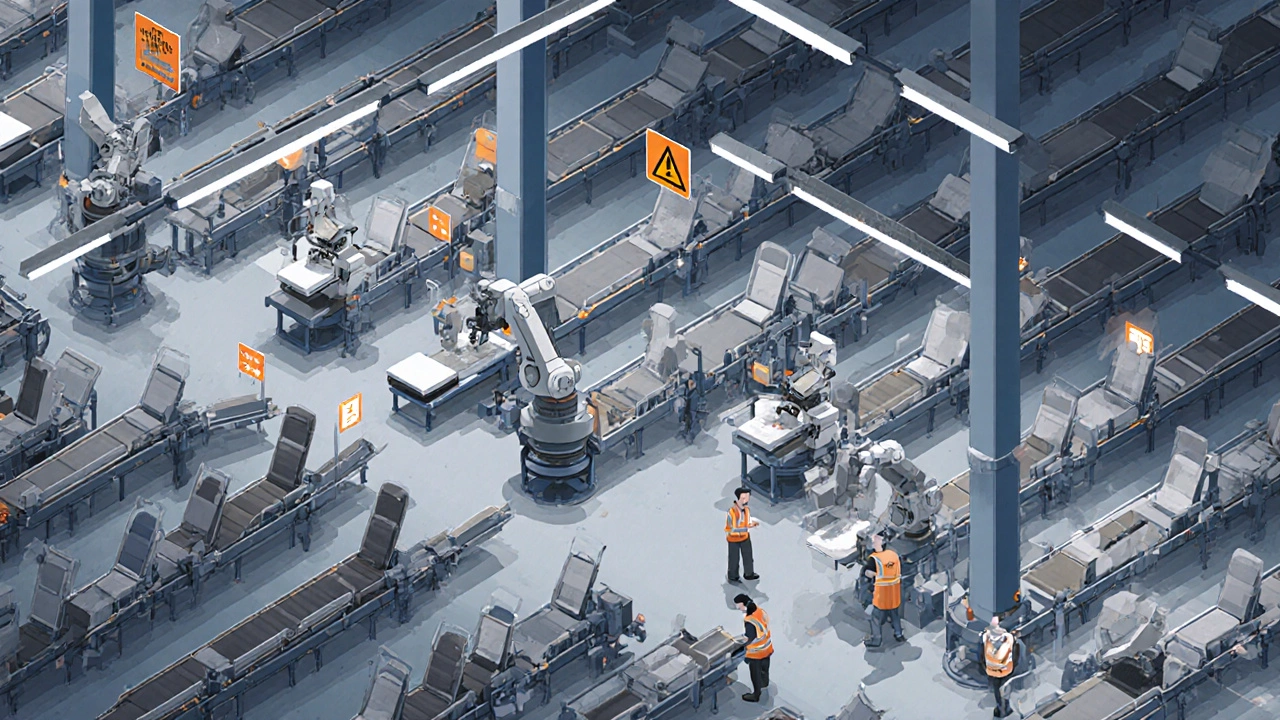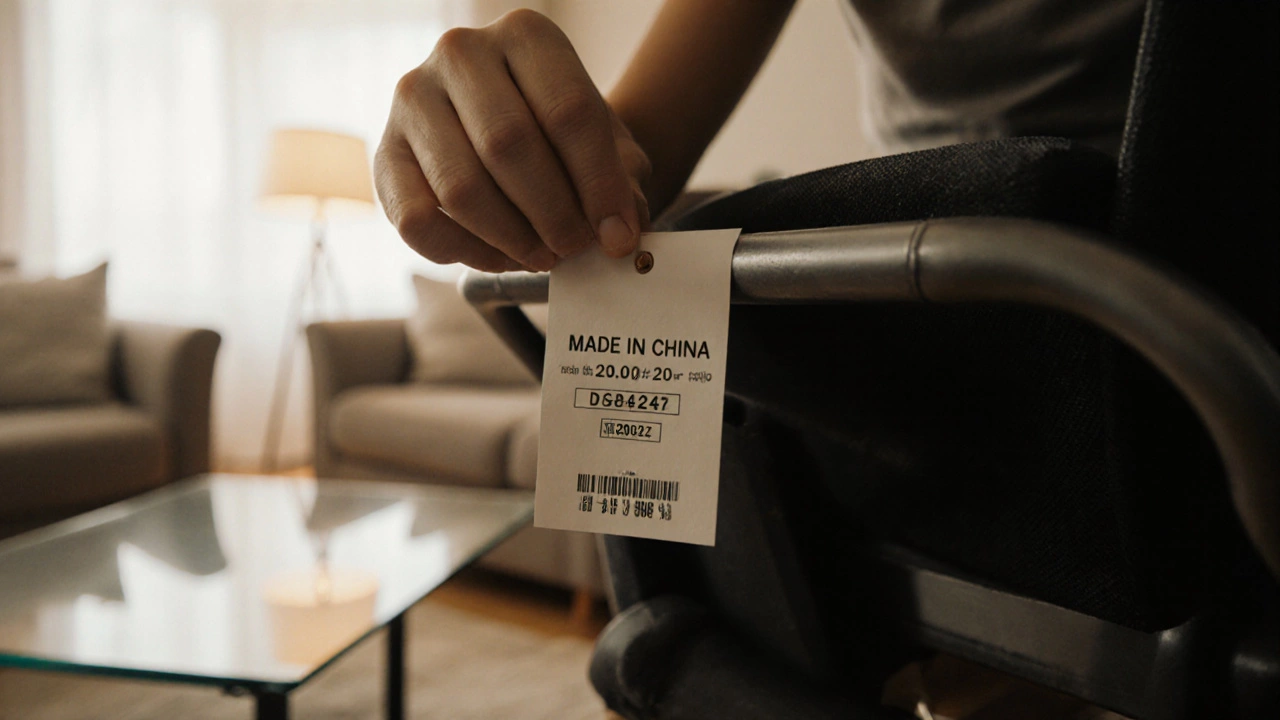Lazyboy Production Calculator
Production Breakdown Calculator
Enter the total number of recliners produced to see the breakdown by country based on Lazyboy's 2024-2025 production statistics.
When people ask "Is Lazyboy made in China?", they’re really wondering how a brand known for comfort ends up on a manufacturing floor halfway across the globe. Lazyboy is a North‑American furniture company that specializes in recliner chairs, power‑adjustable sofas and related seating solutions. Founded in 1927, the brand grew from a small Michigan workshop into a multinational name, but its production story is anything but straightforward.
What Lazyboy actually makes
Lazyboy’s core offering is the Recliner Chair, a piece that blends mechanical engineering with upholstery comfort. Modern models feature motorized footrests, memory‑foam cushions, and Bluetooth‑enabled control panels. The design process stays in the United States - engineers, ergonomics experts and interior designers collaborate at the company’s headquarters in Howey‑In‑the‑Hills, Florida. Once a design is approved, the production blueprint travels to factories worldwide.
Where Lazyboy chairs are built today
In 2025 Lazyboy operates three primary manufacturing zones:
- United States - Two plants in Michigan and Arkansas produce high‑end, made‑in‑America lines aimed at premium retailers.
- China - Two large facilities in Guangdong and Jiangsu handle the bulk of volume‑based models, especially the budget‑friendly Power‑Recline series.
- Eastern Europe - A newer plant in Poland focuses on hybrid models that combine European leather with Asian‑sourced foam.
According to Lazyboy’s 2024 annual report, roughly 58 % of total chair output originated from China, 27 % from the United States, and 15 % from Poland. The numbers shifted slightly in 2025 after new tariffs on Asian imports were introduced by the United States, nudging the company to relocate a portion of its high‑margin production back home.
Why China became a manufacturing hub for Lazyboy
During the early 2000s, Lazyboy faced rising labor costs in its Midwest factories and a limited pool of skilled workers for the increasingly complex mechanical components. Chinese partners offered three decisive advantages:
- Scale - Factories in Guangdong could churn out up to 12,000 recliners per month, a volume unattainable in any U.S. plant.
- Cost efficiency - Average hourly wages for assembly line workers were under $5 in 2005, compared with $20 in Michigan.
- Supply chain proximity - Major foam, metal and textile suppliers are clustered in the Pearl River Delta, reducing lead times for key components.
Lazyboy’s first Chinese contract was signed in 2007 with a joint venture that still operates today under the name Lazyboy China Manufacturing Co.. The partnership allowed the brand to keep design control in the U.S. while leveraging China’s manufacturing muscle.

Current production statistics (2024‑2025)
| Country | % of Total Output | Primary Facility | Year Established |
|---|---|---|---|
| China | 58 % | Guangdong Assembly Plant | 2007 |
| United States | 27 % | Howey‑In‑the‑Hills R&D & Assembly Center | 1995 |
| Poland | 15 % | Warsaw Composite Facility | 2021 |
The table shows how China still dominates the volume segment, but the U.S. share has risen since the 2022 tariff increase (25 % duty on certain upholstered goods). Lazyboy has responded by investing $120 million in automation for its Arkansas plant, which now handles 30 % of the premium line.
How to tell if your Lazyboy chair was made in China
Every Lazyboy recliner carries a label that complies with the U.S. Federal Trade Commission’s "Made in" rules. Look for a small tag inside the seat frame or underneath the armrest. The tag will read one of three things:
- "Made in USA" - indicates full domestic production, including upholstery.
- "Made in China" - parts and final assembly done in China.
- "Assembled in USA from overseas components" - a hybrid model where the frame is sourced abroad but the final upholstery step occurs stateside.
Additionally, a serial number stamped on the metal base can be cross‑checked on Lazyboy’s customer support site. The first two characters denote the factory code: "CN" for China, "US" for United States, and "PL" for Poland.
Pros and cons of China‑made Lazyboy recliners
Pros
- Affordability - Production costs translate to lower retail prices, making power‑recline models accessible to a wider audience.
- Consistent quality - Chinese factories follow strict ISO‑9001 standards, and Lazyboy conducts quarterly audits.
- Rapid availability - Large output reduces lead times, so stores can restock quickly.
Cons
- Perceived prestige - Some buyers associate "Made in USA" with higher status and are willing to pay a premium.
- Tariff exposure - Import duties can increase the final price during trade disputes.
- Logistics complexity - Longer shipping routes raise carbon footprints, a concern for eco‑conscious consumers.

Buying considerations for the mindful shopper
If your decision hinges on origin, start by checking the label and serial number. For those who care about domestic jobs, prioritize the "Made in USA" line, even if it costs 15‑20 % more. If price and availability are the main factors, a China‑made model provides solid value, especially when bundled with Lazyboy’s 10‑year warranty on mechanisms.
Another angle is after‑sales service. Lazyboy’s U.S. service network handles repairs for all models, but parts for China‑assembled chairs sometimes require a two‑week shipping window from the Asian warehouse. Knowing this ahead of time can prevent surprise downtime.
Bottom line
Yes, a substantial portion of Lazyboy recliners are Lazyboy China produced, but the brand maintains a clear split: premium, design‑intensive pieces stay in the United States, while volume‑driven models are built in Chinese factories that meet international quality standards. By reading the label, checking the serial code, and weighing the trade‑off between cost and origin, shoppers can make an informed choice.
Frequently Asked Questions
Are all Lazyboy recliners made in China?
No. While about 58 % of the total output comes from Chinese factories, Lazyboy also produces a significant share in the United States and Poland. The "Made in" label on each chair tells you the exact origin.
How can I verify the country of origin for my Lazyboy chair?
Check the small interior tag that says "Made in …" and locate the serial number on the metal frame. The first two characters of the serial indicate the factory code (e.g., CN for China). You can also contact Lazyboy customer service with the full serial number for confirmation.
Does a China‑made Lazyboy recliner have a different warranty?
The warranty is identical across all production locations. Lazyboy offers a 10‑year mechanical warranty and a 2‑year upholstery guarantee for every recliner, regardless of where it was assembled.
Will future tariffs affect the price of Lazyboy chairs made in China?
Potentially. Higher import duties can raise retail prices, especially for the volume‑driven models. Lazyboy mitigates this by shifting some production back to the U.S., but price fluctuations are still possible during trade policy changes.
Is the quality of a China‑assembled Lazyboy recliner comparable to a U.S.‑made one?
Yes. Chinese factories used by Lazyboy follow ISO‑9001 quality management systems and undergo regular audits. The mechanical components and foam cores meet the same specifications as those produced in the United States. Differences are more about branding perception than actual performance.


Write a comment